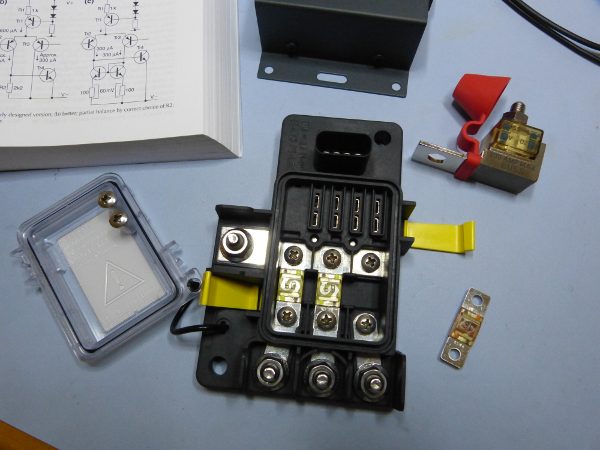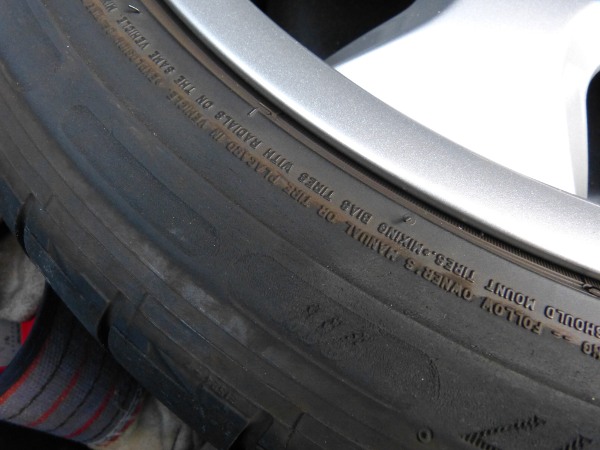Wednesday, August 14, 2013
Audio System DC Power Distribution Design
If you've ever seen a DC arc welder in operation you know the perils of high current short circuits. For this reason I've decided to take every possible safety precaution in the engineering of the audio system power distribution circuitry. The goal is, of course, to feed both Arc Audio KS125.4 amplifiers, each of which is equipped with twin 30 amp fuses. These fuses protect only the amplifier and not the wire that feeds it so protection of the cable needs to be provided elsewhere.
 Arc recommends a minimum #4 power and ground
wire for these amps and it appears the lugs (9mm in diameter) will accept
a slightly larger gauge so I may use #2 or #1 to reduce power losses. I wish
to avoid more than one additional connection to the positive terminal of the
battery in order to simplify battery replacement. That means I need to connect
the battery to a distribution point using a cable capable of handling the total
current required or 120 amps. I could get by with #1, but I'll again likely
use 1/0 to reduce losses and to build in some capacity for future expansion.
Arc recommends a minimum #4 power and ground
wire for these amps and it appears the lugs (9mm in diameter) will accept
a slightly larger gauge so I may use #2 or #1 to reduce power losses. I wish
to avoid more than one additional connection to the positive terminal of the
battery in order to simplify battery replacement. That means I need to connect
the battery to a distribution point using a cable capable of handling the total
current required or 120 amps. I could get by with #1, but I'll again likely
use 1/0 to reduce losses and to build in some capacity for future expansion.
One common recommendation is to make sure the cable supplying the load is fused within 18 inches of the battery terminal. Marine wiring codes are apparently more strict in that they require the fuse within seven inches of the battery. But even if the inline fuse holder is installed that way the small piece of wire between the battery terminal and the fuse holder is unprotected.
The solution to that problem is the Blue Sea 5191 terminal fuse block which protects the entire wire and has the added effect of reducing resistance (and hence power losses) caused by the additional connections that would otherwise be required. I've selected a 125 amp MRBF fuse to protect the 1/0 cable. The fuse is the square tinted plastic component mounted on the stud of the terminal block shown in the upper right portion of the picture.
Since I knew I'd have to fuse the branch circuits going to each amplifier and that the associated cable would be smaller than 1/0 I knew I'd need smaller fuses to protect those wires. I ultimately settled on the Blue Sea Model 7725 SafetyHub 100 fused distribution panel equipped with three outputs. I plan to use two of the outputs for the amplifiers and use the remaining output for a future installation of an amateur radio transceiver. The distribution panel uses familiar MIDI/AMI type fuses but these fuses can be hard to get in local stores so I bought a couple extra just in case. I'll take the time now to point out that it is NOT SAFE to use one of those unfused "single input, multi-output" wiring blocks commonly sold on car audio websites in an application like mine because a short in a branch circuit will result in the "space heater" effect and likely start a fire before the main fuse blows.
A common misconception is that exotic multi-strand cable is required for DC applications and that common household building wire, solid or stranded, is inappropriate. Nothing could be farther from the truth. As long as the cable is rated for the required current it's acceptable for use. The only issue is flexibility. Cable larger than #1 can be difficult to bend if it is constructed, like common building wire, of a relatively few number of thick strands, so in the case where a small bend radius is required a fine strand wire would be required. But even in that case I'd use welding or marine wire since it's typically cheaper per foot than the exotics. The only difference I can see between welding and marine wire, incidentally, is the type of insulation (not a factor in this application) and the fact that the individual strands are tinned in the case of marine wire to prevent corrosion.
Where cables connect to a terminal vs. a lug (as on the amplifiers), I plan to use high-pressure crimps. Some time ago I bought a great Greenlee crimp tool that will do everything from #8 to 4/0 for use in a solar battery plant and the crimps I've made with it so far have convinced me that this is the way to go, as the connections are far stronger than anything involving a screw-type lug or even a soldered lug.
Another Flat Tire
 About 10 minutes into my commute this morning
I took a sweeping turn about as fast as I normally do (which is to say, slower
than light speed but greater than Mach 1) and suddenly felt the car become
unsettled mid-turn. In the moment, as my mind and body worked to figure out
why the steering inputs weren't matching what I was seeing, it felt like push
so I transferred some weight to the front wheels by letting off the throttle.
This is normally not a wise
move due to the possibility of snap oversteer but I made the call
and stuck with it. The technique destabilized the car as one would expect but
I exited the turn without hitting anything so that's the good news.
About 10 minutes into my commute this morning
I took a sweeping turn about as fast as I normally do (which is to say, slower
than light speed but greater than Mach 1) and suddenly felt the car become
unsettled mid-turn. In the moment, as my mind and body worked to figure out
why the steering inputs weren't matching what I was seeing, it felt like push
so I transferred some weight to the front wheels by letting off the throttle.
This is normally not a wise
move due to the possibility of snap oversteer but I made the call
and stuck with it. The technique destabilized the car as one would expect but
I exited the turn without hitting anything so that's the good news.
I couldn't shake the perception that the steering felt "loose", similar to the feeling I experienced regularly with those crappy Pirelli winter tires. As all the tires were near the wear bars I hastily concluded that the front tires were reaching their limits a bit earlier than usual and I might need to keep it under Mach 1 for their remaining lifespan. As I continued the drive I noticed the car a bit out of lock even in a straight line. Expecting the worst, I took the last twisty exit ramp on my route slowly and that confirmed something was not right.
Arriving at the office I got out of the car and began my "post-flight" walk-around. After inspecting the front end and seeing nothing out of the ordinary my gaze turned to the rear of the car -- and that's when I spotted the problem: the left rear tire was severely underinflated, and worse, the sidewall was noticeably worn and heat damaged. I instantly knew I'd have to stick a fork in that tire, since it was done. Compounding the problem was the fact that I knew buying just two new rear tires would be at the very least a fool's errand because the fronts were in need as well, but also quite likely impossible due to the fact that the PS2 has been discontinued. On the upside, I noticed the wheel had not been damaged. Thank goodness for small favors.
During lunch I quickly swapped the flat tire for the spare and then browsed over to Tire Rack to look at my options. A quick check of the PS2 confirmed my suspicions -- one of the sizes I required was no longer available so the decision was made: four new Pilot Super Sports. Before I clicked "buy", however, I decided to check out the reviews of the tire. When you read comments like " Best tire I have ever had, on any vehicle, period" or "it's better than the PS2 and I didn't think that was possible", and "don't buy these for drifting...they won't let go!", it's natural to be skeptical, but it looks like this "bump in the road" will turn out for the better.
The tires should arrive at the dealer tomorrow (one of the perks of being within one day's shipping time of a Tire Rack warehouse) and I've already arranged to bring the wheels to my technician early next week for the swap.
Mileage: 238150



